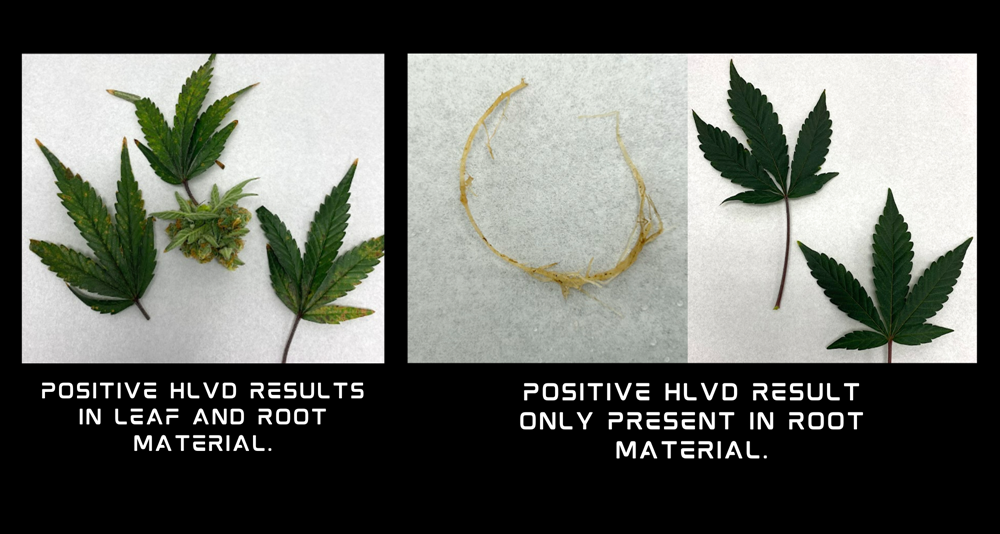What is HLVd in Plants?
Cannabis testing helps ensure product safety and quality by detecting pathogens such as HLVd through advanced root testing. Hop Latent Viroid (HLVd) is a single-stranded, circular RNA molecule that can remain latent in cannabis throughout the plant’s life cycle. HLVd infections can be transmitted even when plants are asymptomatic, which puts entire grow facilities at risk. The symptoms of HLVd-positive plants include decreased potency efficacy, stunted growth, and abnormalities to the leaves and stems. As such, cultivators need to utilize Hop Latent Viroid root testing to evaluate whether it is present in plants early on.
What is the purpose of sampling and testing cannabis roots for HLVd?
Research indicates that HLVd is a mosaic viroid that is not evenly distributed throughout the plant. It is believed that the viroid can be detected in root tissue much sooner than it can be seen in leaf material, indicating that HLVd root testing can be a useful tool for eliminating the viroid in the beginning stages. By complementing traditional HLVd leaf tissue testing with root sample testing, cultivators can positively identify infected plants before they become symptomatic. Before determining the benefits and headstart that HLVd root testing provides, cultivators often had to wait for the viroid to present itself before testing could positively confirm that the plant was infected.
What instrumentation is used to test cannabis roots for HLVd?
Modern Canna utilizes real-time quantitative polymerase chain reaction (qPCR) to test for Hop Latent Viroid in cannabis root samples. The principle behind qPCR is that the laboratory uses root tissue to extract RNA and then converts that into complementary DNA (cDNA). Once the cDNA is created, it is mixed with primers targeted to look for specific sequences of DNA that match both cannabis material and HLVd. After mixing, the samples are placed onto a thermocycler where they undergo cycles of heating and cooling that will allow the DNA to anneal to the primers and generate amplified segments of DNA that will eventually fluoresce when enough material is present. When fluorescence occurs, the laboratory can conclusively determine that the viroid is present in the sample.
Additionally, the laboratory can determine the point in time at which the fluorescence occurred to estimate the viral load present in the sample. The longer a sample takes to fluoresce, the lower the amount of HLVd present. This is extremely helpful for assessing asymptomatic plants since it gives cultivators the ability to track the viral load over time to determine if the viroid is multiplying in the plant.
Modern Canna investigates which method is most effective for detecting HLVd: Leaf testing or Root testing
Modern Canna conducted a case study that involved sampling 41 plants to test for the presence of HLVd in both their leaf and root material. It is important to note that among the plants analyzed, only one displayed HLVd symptoms, while all the plants appeared asymptomatic. This study aimed to determine whether HLVd could be detected in the root material before visible symptoms manifest in the plant, thus leading to the positive detection of HLVd in the leaf material.

Modern Canna found that root testing shows significant potential for identifying HLVd-positive plants at an early stage, even before any noticeable signs of the disease emerge. This finding confirms that cannabis root testing is the most effective way to test for HLVd in asymptomatic cannabis plants. By utilizing root testing techniques to look for HLVd, growers, and researchers can proactively identify infections before they become evident through visible symptoms. Early detection of this viroid spreads rapidly and allows for the implementation of appropriate measures to mitigate the issue. This will minimize its impact on plant health and yield.

As a cultivator, how can you collect and test cannabis root material for HLVd?
To test cannabis root material for HLVd, cultivators will need to collect a few small roots from each plant that needs to be tested. As mentioned previously, root testing is a useful tool to determine if plants that are asymptomatic for HLVd have the viroid present in the latent form. As such, this testing can be conducted at any time, rather than just when a plant is experiencing symptoms. It is important to ensure that this sampling process is done in a sterile manner and that the viroid is not spread throughout the grow facility via cross-contamination. To collect samples for testing, cultivators should:
- Label a 15ml conical tube with the unique sample ID that will be given to each plant being tested.
- Use gloves to collect 1-3 roots that are approximately 2 inches long from each plant.
- Note: Roots will be cleaned when they arrive at the laboratory.
- Place the roots in the corresponding conical tube.
- Repeat this process, changing gloves between each sample, until all samples have been collected.
- Fill out a Modern Canna Virus Chain-of-Custody (COC) and send the root samples to Modern Canna for testing.
For more information on HLVd Testing see our page here about Hop Latent Viroid Testing .
Resources
Hop Latent Viroid Levels and Distribution in Cannabis Plant Tissue. 2022, https://tumigenomics.com/hlvd-distribution
Punja, Zamir. Emerging diseases of Cannabis sativa and sustainable management. National Library of Medicine, 2021, www.ncbi.nlm.nih.gov/pmc/articles/PMC8451794/.
Singh, Anjali. Watch Out For These Viruses And Viroids Infecting Cannabis! Plant Cell Technology, 2022, www.plantcelltechnology.com/blogwatch-out-for-these-viruses-and-viroids-infecting-cannabis/.


